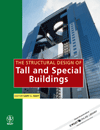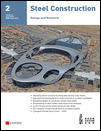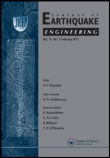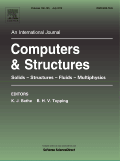
STRUCTURAL DESIGN OF TALL AND SPECIAL BUILDINGS
Scope & Guideline
Transforming Ideas into Architectural Marvels.
Introduction
Aims and Scopes
- Seismic Design and Analysis:
A core focus on understanding and improving the seismic resilience of tall buildings, including innovative materials and systems to mitigate damage during earthquakes. - Wind Engineering:
Research on wind-induced effects on tall buildings, including wind load estimation, aerodynamic performance, and the application of advanced computational fluid dynamics. - Advanced Materials and Systems:
Exploration of new materials such as fiber-reinforced concrete and composite materials for enhanced structural performance, durability, and sustainability. - Structural Optimization and Performance-Based Design:
Development of optimization techniques and performance-based design methodologies to achieve cost-effective and resilient structural solutions. - Innovative Structural Systems:
Investigation into new structural systems such as outriggers, tuned mass dampers, and hybrid systems aimed at improving the stability and safety of tall buildings. - Computational Modeling and Simulation:
Use of advanced computational tools and simulations for analyzing complex structural behaviors under various loading conditions.
Trending and Emerging
- Integration of Machine Learning and AI:
The use of machine learning and artificial intelligence in predicting structural responses and optimizing design processes is becoming more prominent, signaling a shift towards data-driven methodologies. - Sustainability and Eco-Friendly Design:
There is a growing focus on sustainable design practices, including the use of recycled materials and life-cycle assessments to minimize the environmental impact of tall buildings. - Resilience and Disaster Mitigation:
Research on enhancing the resilience of structures to various natural disasters, including earthquakes and wind events, is gaining traction, reflecting a broader concern for safety and sustainability. - Smart Building Technologies:
The integration of smart technologies for real-time monitoring and adaptive management of structural performance is emerging as a significant theme, enhancing the ability to respond to dynamic environmental conditions. - Innovative Structural Systems for High-Rise Buildings:
There is an increasing emphasis on developing and analyzing innovative structural systems, such as hybrid systems and advanced damping techniques, to improve the performance of tall buildings under various loads.
Declining or Waning
- Traditional Structural Materials:
There has been a noticeable decline in research focusing solely on traditional materials like reinforced concrete and steel without innovative enhancements. The trend is shifting towards more advanced materials and composite systems. - Basic Structural Analysis Techniques:
The prevalence of basic structural analysis methods appears to be waning as researchers increasingly adopt advanced computational methods and machine learning techniques to enhance analysis precision and efficiency. - Non-Performance Based Design Approaches:
Research emphasizing non-performance-based design methods is diminishing, as the field moves towards performance-based frameworks that allow for more adaptable and resilient structures. - Static Load Analysis:
There is a reduction in studies focusing exclusively on static load analysis, with a growing emphasis on dynamic responses and real-world conditions affecting tall structures. - Conventional Seismic Design Codes:
Research centered around traditional seismic design codes is declining, as there is a shift towards more innovative and adaptable design parameters that incorporate real-time data and advanced modeling.
Similar Journals

Opir Materialiv i Teoria Sporud-Strength of Materials and Theory of Structures
Advancing the Frontiers of Material Science and Structural EngineeringOpir Materialiv i Teoria Sporud - Strength of Materials and Theory of Structures is a prestigious open-access journal published by BUDIVELNIK, focusing on significant developments in the fields of material science and structural engineering. Established in 2009, this journal facilitates the dissemination of original research articles, theoretical analyses, and case studies related to the strength of materials and structural stability. The journal aims to bridge the knowledge gap between academia and industry, fostering innovation and practical applications in construction and material technology. With its commitment to open access, Opir Materialiv i Teoria Sporud ensures that vital research is accessible to a global audience of researchers, professionals, and students, thereby contributing to the advancement of engineering practices and safety standards. The journal is based in Kyiv, Ukraine, and encourages rigorous academic discourse within its scope, making it an essential resource for those engaged in structural engineering and material sciences.

Frontiers of Structural and Civil Engineering
Pioneering Research in Structural and Civil EngineeringFrontiers of Structural and Civil Engineering, published by HIGHER EDUCATION PRESS, is a premier academic journal dedicated to advancing the fields of architecture, civil, and structural engineering. With an ISSN of 2095-2430 and E-ISSN of 2095-2449, this journal caters to the dissemination of high-quality research and innovative practices from 2012 onwards, highlighting important developments up until 2024. Ranked in the top quartile (Q1) for Architecture and Q2 for Civil and Structural Engineering in 2023, it holds an impressive Scopus ranking of #19 out of 189 in Architecture and #101 out of 379 in Civil and Structural Engineering, reflecting its impact and relevance in the scientific community. This journal invites contributions that demonstrate pioneering approaches, fostering collaboration among researchers, professionals, and students alike, and significantly contributes to the global knowledge base in the engineering disciplines.

Steel Construction-Design and Research
Leading the Way in Steel Construction AdvancementsSteel Construction-Design and Research is a premier journal published by ERNST & SOHN, focusing on the latest advancements and research within the field of steel construction and structural engineering. With an ISSN of 1867-0520 and E-ISSN 1867-0539, this journal serves as a vital resource for engineers, researchers, and academics committed to enhancing the design and performance of steel structures. Located in the United States, its reputation is bolstered by its impressive standing in various Scopus categories; it ranks in the Q2 quartile for Building and Construction, Civil and Structural Engineering, Mechanics of Materials, and Metals and Alloys as of 2023. This journal is particularly significant as it captures high-quality research spanning critical years from 2011 to 2012 and 2014 to 2024, fetching valuable insights into the evolving methodologies and applications in steel construction. Although it does not operate under an Open Access model, its rigorous peer-review process ensures that contributors deliver top-tier research, making it an essential publication for anyone engaged in the field.

JOURNAL OF EARTHQUAKE ENGINEERING
Advancing seismic safety through innovative engineering.JOURNAL OF EARTHQUAKE ENGINEERING, published by TAYLOR & FRANCIS LTD, stands as a pivotal resource in the fields of Building and Construction, Civil and Structural Engineering, and Geotechnical Engineering. With an impressive Q1 ranking in multiple categories for 2023, this journal is instrumental for researchers, professionals, and students committed to advancing knowledge in earthquake engineering and its practical applications. As a platform that spans the years from 1997 to 2024, it highlights significant contributions to safety, risk, reliability, and quality in engineering practices. While the journal operates on a subscription basis, its highly regarded articles, bolstered by robust Scopus rankings—such as rank #46 in Building and Construction—underscore its credibility and influence in shaping standards and methodologies within the discipline. Promoting innovative and evidence-based approaches, the JOURNAL OF EARTHQUAKE ENGINEERING is essential reading for anyone engaged in the science and technology of earthquake-resistant structures.

COMPUTERS & STRUCTURES
Exploring New Frontiers in Engineering MethodologiesCOMPUTERS & STRUCTURES is a leading interdisciplinary journal published by Pergamon-Elsevier Science Ltd, focusing on the application of computer methods in the fields of civil and structural engineering, mechanical engineering, materials science, and modeling and simulation. With a prestigious history dating back to its inception in 1971, this journal is committed to advancing the knowledge and methodologies that integrate computational techniques with structural analysis and design. Recognized in 2023 with a Q1 ranking across several categories, including Civil and Structural Engineering and Computer Science Applications, COMPUTERS & STRUCTURES emphasizes the importance of innovative research that pushes the boundaries of traditional engineering practices. Although the journal does not currently offer open access, it remains an invaluable resource for researchers, professionals, and students seeking to disseminate and discuss groundbreaking findings that are shaping the future of engineering and materials science. The rigorous peer-review process ensures the publication of high-quality articles that contribute to the global discourse in these critical fields.

Journal of Structural Integrity and Maintenance
Exploring Cutting-edge Research in Structural IntegrityThe Journal of Structural Integrity and Maintenance, published by Taylor & Francis Ltd, serves as a prestigious platform dedicated to the advancement of knowledge in the fields of structural integrity, civil engineering, and materials science. With an ISSN of 2470-5314 and an E-ISSN of 2470-5322, this journal is uniquely positioned to address the critical challenges faced by researchers and professionals in building and construction, mechanical engineering, and related domains. Since its inception in 2016, this journal has been consistently recognized for its quality, currently holding a Q2 rank across several disciplines, including Building and Construction and Civil and Structural Engineering in 2023. The journal aims to publish high-quality research that contributes to the understanding and maintenance of structural integrity, fostering innovations that promote safety, efficiency, and sustainability in engineering practices. Researchers and students alike are encouraged to engage with this rich repository of knowledge, which plays a vital role in shaping future advancements in structural engineering and materials science.

Journal of Constructional Steel Research
Transforming Ideas into Steel SolutionsJournal of Constructional Steel Research, published by Elsevier Ltd, stands as a leading platform in the realm of constructional steel research since its inception in 1980. With a robust focus on Building and Construction, Civil and Structural Engineering, Mechanics of Materials, and Metals and Alloys, this prestigious journal has earned its place in the Q1 category across multiple disciplines, symbolizing excellence in scholarly contributions. The journal's impressive Scopus rankings further underscore its significance, ranking 30th out of 223 in Building and Construction, and exhibiting strong standings in other related fields. Researchers, professionals, and students will find this publication an invaluable resource, offering access to the latest findings and innovations in constructional steel, necessary for advancing practices in engineering and material sciences. Although it does not operate under an open-access model, the content is meticulously curated to ensure high-quality, peer-reviewed research, continuing to shape the future of steel construction methodologies.

Bulletin of the New Zealand Society for Earthquake Engineering
Fostering knowledge for a resilient future against seismic challenges.Bulletin of the New Zealand Society for Earthquake Engineering (ISSN: 1174-9857, E-ISSN: 2324-1543) is a leading scholarly journal published by the New Zealand Society for Earthquake Engineering, Inc., dedicated to advancing the field of earthquake engineering. Since its inception in 1970, the journal has provided a vital platform for the dissemination of innovative research, technical studies, and case reports related to civil and structural engineering, as well as geotechnical engineering and engineering geology. Recognized for its significant contributions, the journal holds a Q2 ranking in both the Civil and Structural Engineering and Geotechnical Engineering and Engineering Geology categories as of 2023. It serves as an invaluable resource for researchers, professionals, and students keen on enhancing their understanding of earthquake resilience and engineering practices. While the journal operates under subscription-based access, its rigorous peer-review process ensures that published articles meet the highest academic standards, making it a credible source for the global engineering community.

International Journal of Steel Structures
Exploring Excellence in Structural DesignWelcome to the International Journal of Steel Structures, a distinguished publication dedicated to advancing the field of civil and structural engineering since its inception in 2010. Published by the Korean Society of Steel Construction (KSSC), this journal aims to provide a platform for researchers and professionals to share innovative findings and essential insights related to steel structures, emphasizing both theoretical and applied research. With an impact factor that reflects its growing recognition—ranking in Q3 within the civil and structural engineering category—the journal has positioned itself as a significant contributor to the body of knowledge in this vital field. Although currently not an open-access publication, it remains an invaluable resource for students and scholars keen on exploring contemporary challenges and advancements in steel construction. Located in Seoul, South Korea, the journal continues to evolve, converging its presence into the future, with publication efforts spanning through to 2024. Engage with us as we explore the innovative applications and developments in the realm of steel structures.

Buildings
Pioneering Research at the Intersection of Architecture and EngineeringBuildings is a premier peer-reviewed journal published by MDPI, focusing on the multidisciplinary aspects of architectural and civil engineering. Established in 2011, this Open Access journal has quickly gained recognition in the academic community and is currently classified in the Q1 category for Architecture and Q2 for Building and Construction, as well as Civil and Structural Engineering, reflecting its significant impact within these fields. With Scopus rankings placing it in the top tier of architecture and construction disciplines, Buildings provides a platform for innovative research and practical applications that push the boundaries of knowledge in building design, sustainability, and infrastructure development. The journal, based in Switzerland and intended for an international audience, welcomes various types of content including research articles, reviews, and case studies, ensuring a comprehensive resource for researchers, professionals, and students alike.